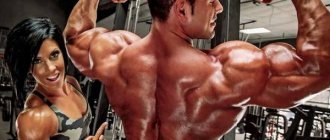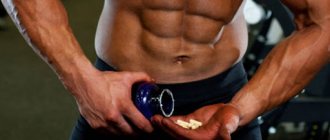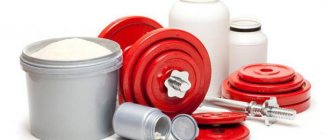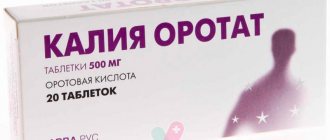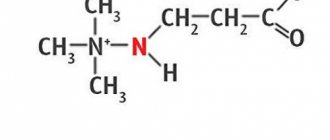Asparkam in bodybuilding and sports is a legal and safe remedy. It is recommended by sports doctors and trainers, especially in the summer. This is a medicine containing potassium, magnesium and aspartic acid, which promotes the transport of these elements throughout the body. Available in ampoules and tablets.
The drug has a positive effect on the functioning of the heart, increases its ability to contract, reduces the risk of hemorrhages and blood clots, and relieves seizures. In addition, the drug improves the performance of patients suffering from heart rhythm disorders. Normalizes the level of electrolytes in the blood and improves nerve conduction. Thanks to magnesium in the composition, it stabilizes energy metabolism and the functioning of the central nervous system, reduces the level of stress hormone in the body, inhibiting the release of adrenaline, dopamine and norepinephrine into the blood. It is available in pharmacies without a prescription and can be combined with other drugs.
Asparkam[edit | edit code]
Yuzhakov Anton Description of Asparkam from 3.14 min
Packaging varies depending on the manufacturer Asparkam from Pharmapol-Volga Asparkam from Renewal Asparkam-L (injection solution)
Asparkam
(international name: potassium and magnesium aspartate) is a medicine for quickly replenishing potassium and magnesium deficiency in the body and normalizing electrolyte balance.
It also contains aspartate (aspartic acid), a carrier of these ions across cell membranes. Does not have
an anabolic effect .
It is used for heart rhythm disturbances, coronary heart disease (angina) and for the prevention of stroke. Often prescribed for the development of muscle cramps.
Price
asparkam 40-120 rubles per package.
Analogues:
more expensive Panangin from GEDEON RICHTER. No advantages over asparkam have been proven in studies.
Best before date.
3 years.
Storage conditions:
in a dry place at a temperature not exceeding 25 °C.
Keep out of the reach of children. Packaging
of 50 tablets in a blister;
50 tablets in a blister, 1 blister in a pack. Dispensing category
: without prescription.
Composition of dosage forms[edit | edit code]
Pills
(have a specific smell):
- Active ingredients: 1 tablet contains magnesium aspartate 175 mg (0.175 g), potassium aspartate 175 mg (0.175 g);
- Excipients: corn starch, polysorbate-80, calcium stearate, talc.
Injection
:
- Active ingredients: 1 ml of solution contains anhydrous magnesium aspartate 40 mg (3.37 mg magnesium), anhydrous potassium aspartate 45.2 mg (10.33 mg potassium);
- Excipients: sorbitol (E 420), water for injection.
Release forms and methods of application
The drug is available in two forms: tablets and injections. The maximum single dose is 500 mg. For home use, the drug is usually prescribed orally. Administration of the drug intravenously can only be prescribed by a doctor in an individual dosage. This treatment is carried out in a hospital setting.
How to take Asparkam tablets
Take 1-2 pcs. 3 times a day after meals. Course duration is 3-4 weeks. It is better to take it in the morning and afternoon, when metals are better absorbed.
Action[edit | edit code]
Asparkam is a medicine that regulates metabolic processes. The mechanism of action is associated with the role of aspartates to transport magnesium and potassium ions into the intracellular space and their participation in metabolic processes. Asparkam eliminates electrolyte imbalance, magnesium and potassium deficiency, reduces myocardial excitability and conductivity, exhibits a moderate antiarrhythmic effect, improves metabolism in the myocardium and coronary circulation, and also reduces the sensitivity of the myocardium to cardiac glycosides and the manifestations of their toxicity. Mg2+ ions activate Na+, K+-ATPases. In this connection, the intracellular concentration of Na+ ions decreases and the flow of K+ ions into the cells increases. When the concentration of Na+ ions inside the cell decreases, the exchange of Na+ and Ca2+ ions in the smooth muscles of blood vessels is inhibited, which leads to their relaxation. K+ ions stimulate the synthesis of ATP, glycogen, proteins, and acetylcholine. K+ and Mg2+ ions support the polarization of cell membranes. Aspartate is a carrier of K+ and Mg2+ ions and promotes their entry into the intracellular space. Once in the cell, aspartate is also involved in metabolic processes, promotes the synthesis of amino acids, amino sugars, nucleotides, nitrogen-containing lipids, and corrects disturbances in the energy metabolism of ischemic myocardium.
It is quickly and completely absorbed and excreted mainly by the kidneys. The concentration of potassium and magnesium in the blood reaches a maximum 1-2 hours after taking the drug. From the blood, the drug enters cardiomyocytes in the form of K+, Mg2+, and aspartate ions and is included in cellular metabolism.
About the effect of the drug
A drug with proven effectiveness is indicated for replenishing magnesium and potassium. One tablet contains metal aspartates in equal parts. Aspartates themselves play a transport function, delivering ions into the intercellular space. The prescription of the medication is based on the role of macroelements in the human body. This is a powerful regulator that is prescribed for the complex treatment of diseases caused by electrolyte imbalance.
Potassium maintains sufficient sodium levels, normal acid-base balance and cell saturation with fluid, and is involved in the formation of glycogen - pure energy. Due to this, the metal ensures normal intracellular pressure, conduction of nerve impulses, promotes healthy kidney function and cleansing of toxins. Potassium supports mental and physical performance.
Magnesium also ensures the proper functioning of all muscles, including the heart. Its main role is to regulate the functioning of the nervous system, and therefore all life activity. The metal is involved in carbohydrate-protein metabolism, energy processes, and normalizes blood circulation. Deficiency of both elements provokes the development of cardiac, neurological, gastrointestinal, and urological diseases.
Indications for use[edit | edit code]
- as part of complex therapy for heart failure, conditions after myocardial infarction, heart rhythm disturbances (mainly ventricular arrhythmias) caused by electrolyte disturbances;
- to enhance the effectiveness and improve the tolerability of cardiac glycosides;
- in conditions accompanied by hypokalemia and hypomagnesemia (including overdose of saluretics).
Recommendations for use in sports[edit | edit code]
- Prolonged intense physical activity.
- Maladjustment (overtraining). As an auxiliary therapeutic agent.
- Cardiopsychoneurosis.
- Heart rhythm disturbances.
Combination of asparkam with other drugs
Sports doctors often prescribe a combined dose of asparkam and riboxin. How does Riboxin work:
- Normalizes blood pressure.
- Stabilizes metabolic processes.
- Increases nucleotide metabolism.
- Increases energy.
- Strengthens the heart muscle.
Asparkam is often prescribed together with Riboxin, since the drugs enhance each other's effectiveness. And they are inexpensive. All components in the products are beneficial to the body and help maintain stamina and energy during heavy exercise.
In addition, the drugs can be combined with other supplements (for example, creatine), since the likelihood of negative reactions from the body is minimal. When taking tablets together, the dosage of asparkam is 1 tablet three times a day. Also Riboxin, one tablet three times a day.
Contraindications[edit | edit code]
- Hypersensitivity to the components of the drug;
- acute and chronic renal failure;
- Addison's disease;
- hyperkalemia, hypermagnesemia;
- atrioventricular block II-III degree;
- cardiogenic shock (BP<90 mmHg).
Appropriate safety precautions for use. With prolonged use of the drug, it is necessary to monitor the level of potassium and magnesium in the blood, and regular monitoring of electrolyte hemostasis and ECG data is also necessary.
When is admission prohibited?
It is better not to take asparkam if there is a slow transmission of impulses from nerve endings or disturbances in the functioning of the heart. In addition, it is not recommended to take the drug simultaneously with other supplements that retain (promote the accumulation of) potassium in the body. Such drugs include veroshpiron, triamterene and others.
If you have kidney problems, it is important to take asparkam with extreme caution and only after consulting a doctor. Excessive accumulation of potassium poses a great health hazard.
The drug is not prescribed even if there is obvious muscle weakness, because it can only lead to an increase in this effect. It is not recommended for allergy sufferers, as well as people with individual intolerance to the components in the composition.
The instructions for the drug include the following contraindications: hyperkalemia, hypermagnesemia, renal failure, masthenia.
Side effects[edit | edit code]
Adverse reactions develop very rarely:
- from the digestive tract: nausea, vomiting, diarrhea, abdominal pain, discomfort or burning sensation in the epigastric region, gastrointestinal bleeding, ulcers of the mucous membrane of the digestive tract, dry mouth;
- from the cardiovascular system: impaired myocardial conduction, decreased blood pressure, AV block;
- from the central and peripheral nervous system: paresthesia, hyporeflexia, convulsions;
- allergic reactions: itching, redness of the facial skin, rash;
- from the respiratory system: possible respiratory depression (due to hypermagnesemia);
- others: feeling of heat.
Interaction with other drugs and other types of interactions.
Due to the presence of potassium ions in the drug, when Asparkam is used with potassium-sparing diuretics, ACE inhibitors, beta-blockers, cyclosporine, the risk of developing hyperkalemia increases (control of the level of potassium in the blood plasma is necessary) and the inhibitory effect on intestinal motility increases.
The drug inhibits the absorption of oral forms of tetracycline, iron salts and sodium fluoride (it is necessary to adhere to a three-hour interval between doses).
Asparkam enhances the effect of drugs that stimulate trophic processes in the myocardium; prevents the development of hypokalemia caused by the use of saluretics, corticosteroids, cardiac glycosides. Asparkam reduces the cardiotoxic effect of cardiac glycosides.
When used simultaneously with antidepolarizing muscle relaxants, the neuromuscular blockade is enhanced, and with anesthetic agents (ketamine, hexanal, fluorothane, etc.) the central nervous system is depressed. Asparkam may reduce the effectiveness of neomycin, polymyxin B, tetracycline and streptomycin.
Overdose.
At the moment, no cases of overdose have been registered.
Asparkam in bodybuilding and strength sports
Constant stress, high loads on the muscle corset and joints, increased removal of water from the body - all this leads to depletion of the energy reserves of cells. This is especially true for people actively involved in sports at a professional level. The positive properties of asparkam have made it a popular drug among athletes and bodybuilders.
I use it as a safe supplement to increase the effectiveness of workouts and speed up recovery processes after them. This is an approved non-steroidal drug that is recommended by sports doctors. It is quickly absorbed into the blood, reaching maximum concentration within an hour or two after administration.
Why is asparkam used in sports?
- During active periods, especially in summer.
- During the drying process, when taking diuretics.
- When gaining weight and increasing the volume of fluid consumed.
- With periodic spasms and cramps in the muscles.
- To strengthen the nervous system and improve heart function.
- To maintain the required level of micro and macroelements in the body.
Please note that the product does not contain hormones or stimulants. Its effect is not anabolic. However, it has a positive effect on the heart, activates the increase in muscle mass naturally, and normalizes metabolism, which is very important for people involved in sports.
Why potassium and magnesium
These two elements are very important for the functioning of the heart. Moreover, potassium is considered the most effective, and magnesium mainly acts as a conductor of its ions into the cell. A sufficient amount of these elements in the body ensures:
- correct conduction of the cardiac impulse;
- good contractile function of the myocardial muscles;
- elasticity of the walls of blood vessels;
— regulation of metabolic processes in the heart muscle;
- decrease in blood viscosity.
What to do if you have arrhythmia and low blood pressure
Currently, arrhythmias are quite common. There are frequent cases of their combination with hypotension (low blood pressure), which aggravates the condition of patients and requires an integrated approach to diagnosis and treatment. It is important to understand that there are a large number of different types and forms of arrhythmias that have completely different causes. Any disruption of the heart is a serious symptom; they can be classified as so-called “red signs”, especially if we are talking about an acute arrhythmia, which is accompanied by a decrease in blood pressure. Therefore, the answer to the question: “I have arrhythmia and low blood pressure, what should I do?” – there will be a timely request for help from a specialist: family doctor, therapist, cardiologist.
Reviews
Having analyzed the reviews about asparkam, a mixed opinion emerges. The main thing that attracts is the affordable price of the drug and its effectiveness. At the same time, there are also people who have no idea why the supplement is needed and what benefits it can bring.
The most common mistake is that many people consider asparkam to be an ordinary “vitamin” and do not take it seriously. In fact, this is not so. Incorrect and irregular intake can lead to serious problems in the body.
When used correctly, the drug does not cause any problems and is well tolerated by the body. As for its effectiveness, it is very difficult to prove it due to the lack of obvious manifestations.
What is better and what is the difference between the drugs
Panangin normalizes heart function. The drugs belong to different groups, but what they have in common is that they improve myocardial function.
Panangin is prescribed for a lack of microelements in the blood.
Riboxin dilates blood vessels, improves metabolism in the myocardium and normalizes blood pressure. Panangin is used for arterial hypertension. Riboxin prevents the development of strokes. The attending physician decides which medication to prescribe to the patient.
Lozap and hypertension: rules for using the medicine
Why is there not enough potassium in the body?
Not everyone knows why Asparkam is prescribed. And this is done mainly for patients who have a deficiency of potassium ions. Why might this happen?
- even with proper nutrition, microelements enter the body with food in very small quantities;
— a lot of potassium and magnesium are lost during heavy sweating in hot weather and with increased physical activity;
— the absorption of microelements is impaired due to hormonal imbalances, diabetes mellitus or metabolic diseases;
- gastrointestinal diseases, for example, gastritis or pancreatitis, also lead to a deterioration in potassium absorption;
— loss of these necessary elements often occurs with stomach disorders and intestinal infections, especially accompanied by diarrhea;
- Drinking alcohol, foods containing caffeine, and certain medications also contribute to excess potassium excretion. Therefore, for such conditions, the drug “Asparkam” is often prescribed. Why it is needed will become clear when you understand the consequences of a lack of these microelements.
Panangin for athletes how to take
Today we will discuss the rules for taking our expensive drug - Panangin. Let's look at the question - how to take it correctly, let's touch on the topic of hangover and the role of our medicine in this process.
There are sections that are also present in the instructions for this drug, located on my blog, this was done intentionally.
Everyone who reads this article can study the issue comprehensively, without gaps; those who want to read the instructions themselves can follow the link above, or find it in the site navigation, it is intuitively easy and understandable.
So, the beginning of the article is already under this line, happy reading and good health!
A lack of potassium and magnesium in the body leads to the development of arrhythmia, the functioning of the heart muscles is disrupted, and blood pressure increases. For these reasons, panangin is prescribed for the treatment of heart and vascular diseases. This product contains microelements necessary for the body. It is important to know how to take Panangin correctly for prevention.
Key points about the drug
The product is produced in Hungary and has 2 dosage forms - tablets and ampoules. The active ingredients of the drug, which help with heart diseases, are potassium and magnesium. Excipients include:
- magnesium stearate;
- silica;
- starch;
- talc;
- povidone.
The tablet shell contains talc, macrogol 6000, titanium dioxide, methacrylic acid copolymer.
The product for preparing a solution inside a vein contains magnesium, potassium, and injection water. Panagin Forte tablets are also produced. They differ from the usual drug, with double the content of magnesium and potassium.
Properties of the medicine
When potassium and magnesium levels in the body are low, this leads to various diseases. Metabolic disorders can be noticed in the myocardium, hypertension can develop, and plaques form in the coronary arteries. Panangin will help compensate for the lack of elements such as magnesium and potassium. If the physiological balance between magnesium and potassium is disturbed, the following may occur:
- contractility of the heart muscle will decrease;
- the rhythm of organ contractions will change;
- the toxic properties of cardiac glycosides will increase.
A heart attack is the root cause leading to death and loss of ability to work. Based on observations, those patients who died had magnesium ions 2 times less than people with a healthy heart.
Magnesium has an anti-ischemic effect on myocardial tissue cells. It can increase the flow of blood through the coronary vessels.
If there is a deficiency of potassium, a person may experience dangerous arrhythmias, the heart will not work properly, and a stroke is possible. Therefore, if you increase the dose of potassium intake per day, the threat of the formation and development of a stroke will decrease by 40%.
Thanks to panangin, the heart will become stronger, metabolic processes will be normalized in it, its function will improve, the drug will prevent premature wear and tear, aging, and the risk of arrhythmia, hypertension, and atherosclerosis will decrease. The heart impulse will be perfectly conducted, the walls of the blood vessels will be elastic.
The active ingredients will also slow down the growth of atherosclerotic plaques and help reduce excessive blood viscosity, which will prevent blood clots from forming.
When is the drug prescribed?
Panagin is used for the following diseases and conditions of the patient.
- Hypokalemia.
- Heart attack.
- Hypomagnesemia.
- Cardiac inferiority.
- Diarrhea.
- Prolonged vomiting.
- Paroxysmal tachycardia.
- Intoxication.
- Supraventricular tachycardia.
Panangin is prescribed for use of glucocorticosteroid drugs, diuretics, and laxatives.
The drug will help close open heart defects in infants and strengthen their heart muscles. It is also prescribed to children to relieve seizures that are associated with a lack of potassium and magnesium.
Today, Panangin is quite often prescribed to people over 45 years of age, as well as:
- For patients with diabetes mellitus, to prevent complications in the organ.
- Patients who are losing weight drink laxatives and diuretics.
- Women who take hormonal contraceptives.
- For those who suffer from cramps and pain in the muscles of the calves.
- As a preventative measure for heart complications due to influenza and other infections.
- For people visiting baths and saunas.
Taking the drug
The use of panangin as a prophylaxis or for the treatment of heart and vascular diseases is carried out according to the instructions, or following the doctor’s instructions.
Often taken 3 times a day, 1-2 tablets at a time. It is recommended to drink it after eating food and take it with enough liquid.
When the drug penetrates into an acidic environment, its effectiveness decreases. The course of treatment is 1-3 months.
The use of the medicine can be carried out when tests are carried out for a lack of potassium and magnesium. Also, if the patient takes diuretics, which can flush these substances out of the body.
Panangin can be prescribed as a source of the required vitamins and minerals. The drug must be taken 2 times a day, 2 tablets. The course of prevention lasts a month.
Important! If the patient has suffered from a cold, the flu, also in case of physical activity, or during diets with restricted food intake, the medicine is used 3 times a day, 2 tablets for 14 days.
For heart and vascular disease, you need to take the drug 3 times, 3 tablets per dose. This dose is the maximum, therefore it cannot be exceeded.
How does panangin work for hangovers?
The fact is that alcohol is a strong diuretic, i.e. diuretic. This is why you often want to go to the toilet during a feast with alcohol. As a result, too much magnesium and potassium are excreted from the body in the urine.
Thus, the next morning with a hangover, a severe deficiency of potassium and magnesium occurs in the body, especially the first element. At the same time, a lack of magnesium leads to saturation of the blood with calcium, which is washed out of the bones in excess. A lack of calcium in the skeletal system threatens such a serious disease as osteoporosis.
At the same time, an excess of calcium in the human body is the cause of obvious hangover symptoms, such as:
- nervous excitability,
- chills,
- muscle weakness,
- heart problems.
Thus, panangin (or its analogue Asparkam), replenishing the lack of these two important elements in the body, leads to the rapid elimination of the listed hangover symptoms.
By the way, this drug is an integral part of a home first aid kit for emergency drug treatment.
How to take Panangin for a hangover
To relieve hangover symptoms, it is enough to take 1-2 tablets of Panangin. However, in most cases, when the consequences of excessive alcohol intake are not very pronounced, it is better to get by with brine and other folk remedies, because Panangin has a number of contraindications for use, namely:
- diseases of the cardiovascular system,
- renal failure (acute and chronic),
- excess potassium and magnesium in the body,
- myasthenia gravis in severe forms.
In addition, the drug itself has side effects such as nausea, vomiting, headache, abdominal pain, etc.
It should also be borne in mind that panangin is effective for hangovers only as part of complex therapy for alcohol intoxication. This drug is not suitable as an emergency medicine or for self-use to eliminate unpleasant symptoms.
If you really can’t wait to take a pill, a much more effective remedy for relieving a hangover is Magnesol (the active substance is magnesium diasparkal), which can be used as an independent remedy for a not very severe hangover.
Contraindications
The medicine must not be taken in the following cases:
- metabolic acidosis;
- dehydration;
- myasthenia gravis;
- hemolysis;
- renal failure;
- hyperkalemia;
- hypermagnesemia;
- cardiogenic shock;
- amino acid metabolism is disrupted.
Source: https://med-perevozka.ru/lechenie/panangin-dlya-sportsmenov-kak-prinimat.html
How to strengthen your heart during sports and increased stress
Evgeniy Suborov tells how to strengthen the heart when jogging and restore electrolyte balance.
The popularity of running in our country is growing every year, and this is not surprising. Most people believe that it helps improve health, relieve stress and get rid of extra pounds. Jogging is one of the best ways to strengthen the cardiovascular system and prevent its diseases.
Back in 1935, scientists analyzed data from medical examinations of 16,000 schoolchildren over 30 years and found that physical activity practically does not strain the heart.
That even marathon running is safe was demonstrated in 1985, when a group of middle-aged men took part in the Boston Marathon who had suffered a myocardial infarction several years before the start. Regular exercise undoubtedly has a positive effect on the entire body, but primarily on the cardiovascular system.
We should not forget, however, that during serious physical activity (baseline period, reaching peak physical fitness), the cardiovascular system is also subject to increased stress. The more intense the workout, the greater the load on the heart muscle.
During training, an athlete’s heart gradually adapts to performing heavy physical work, and a well-designed training plan allows one to strengthen the activity of the heart muscle and develop reserve mechanisms. However, sometimes it is necessary to “support” our heart and blood vessels a little.
Electrolytes help our body function normally; they are necessary for the gastrointestinal tract, cardiovascular, muscular and nervous systems. The most important for the body are potassium, magnesium, sodium and calcium.
Maintaining electrolyte balance for a runner is an important part of a successful training process. Electrolyte imbalances can prevent an athlete from performing well in competition, causing muscle spasms and decreased performance.
And of course, the deterioration of the cardiovascular system during strenuous training will partly be a consequence of a violation of the electrolyte content in our body. But that's not all.
How do you feel about the consequences of an electrolyte imbalance: dizziness, fatigue, nausea, constipation, dry skin, muscle weakness, decreased joint mobility?
One of the causes of electrolyte imbalances is excessive sweating during training, especially in hot weather, as well as insufficient replenishment of electrolytes during the recovery period.
Potassium performs a number of useful functions in the body: – regulates the exchange of water and sodium, – participates in the conduction of nerve impulses to muscles, – normalizes myocardial contractions, – activates a number of enzymes and participates in the processes of energy formation, – participates in the synthesis of proteins and carbohydrates, – facilitates the movement of nutrients into cells and promotes the accumulation of glycogen,
– smoothes out the negative effect of sodium on blood pressure (sodium leads to increased blood pressure).
In the absence of chronic diseases, potassium deficiency is rarely observed: the body has a certain supply of this electrolyte and we do not lose much potassium even during the most difficult workouts. However, with an inadequate diet and increased stress on the cardiovascular system, it becomes important to maintain potassium balance.
The normal level of potassium in the blood is 3.5–5.5 mmol/l, and the daily intake is 3600 mg.
Magnesium is called the “hidden ion” because it is inextricably linked to the metabolism of potassium and phosphorus.
The role of magnesium in the body: – maintains normal tone (elasticity) of blood vessels, – improves myocardial contractility, – promotes the absorption of potassium, – helps the body synthesize proteins, – facilitates the work of certain enzymes, – promotes muscle contraction and relaxation, – helps maintain blood pressure, – increases the body’s resistance to stress, – has a calming effect, – reduces the level of anxiety and irritability, – helps reduce cholesterol levels,
– helps normalize blood clotting and bone metabolism.
Magnesium deficiency is also quite rare, but its connection with potassium metabolism makes it important to maintain the balance of this ion. Magnesium deficiency causes a range of symptoms, from drowsiness and muscle weakness to hallucinations and numbness in the limbs. The normal level of magnesium in the blood is 0.66–1.07 mmol/l, and the daily intake is 400 mg.
Of course, the best source of electrolytes is food, but a complete diet is often inaccessible to the ever-hurrying and busy city dweller.
But what about increased physical activity, when maintaining electrolyte balance is so important for good results? The way out of this situation is to take potassium and magnesium supplements, for example, Panangin.
Preparations from the Panangin line contain microelements that are beneficial for the heart and muscles, thereby supporting the cardiovascular system.
Panangin’s “pedigree” dates back more than 30 years, which does not prevent it from remaining a topical remedy, since the microelements in the preparation are contained in an organic, easily digestible form - in the form of aspartic salts. This allows the use of balanced moderate dosages of microelements to obtain targeted effects: – increases the absorption of potassium and magnesium in the intestine, – promotes the flow of potassium and magnesium to the place of their action (inside the cell),
– participates in the synthesis of energy molecules ATP in cells.
It is worth noting that a new enhanced formula with potassium and magnesium has recently appeared - Panangin Forte. One tablet of the new product contains twice as many microelements. This is convenient because it allows you to reduce the number of pills you take per day.
Of course, during periods of heavy physical activity, during active preparation for competitions, and even in the off-season, it is important to maintain optimal water and electrolyte balance. If it is impossible to provide a balanced diet, potassium and magnesium supplements will provide invaluable assistance.
Their effectiveness in sports has been confirmed by a number of studies. One of the studies showed a positive result from the use of magnesium salts in athletes, among whom were marathon runners (O. A. Gromova et al. RMZh. Cardiology. 2020. No. 9. P. –571).
Review studies have shown that electrolyte supplementation is popular among both recreational athletes (Knapik JJ, et al. Sports Medicine (Auckland, Nz), 2016; 46, 103–123) and professional athletes (Lun V, et al. Int. J Sport Nutr Exerc Metab.
2012 Feb;22(1):31-7.).
The material was written with the support of JSC Gedeon Richter (Hungary).
Source: https://newrunners.ru/mag/kak-ukrepit-serdce/

